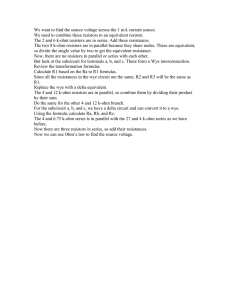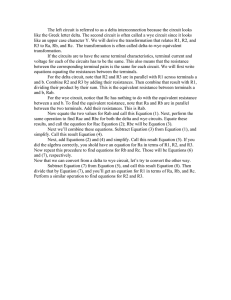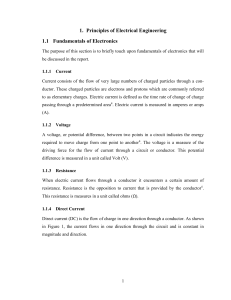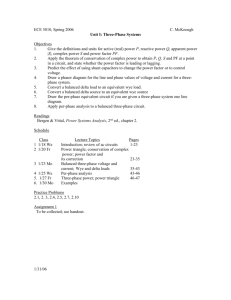Chapter 2 — Wye-Delta Transformations
advertisement
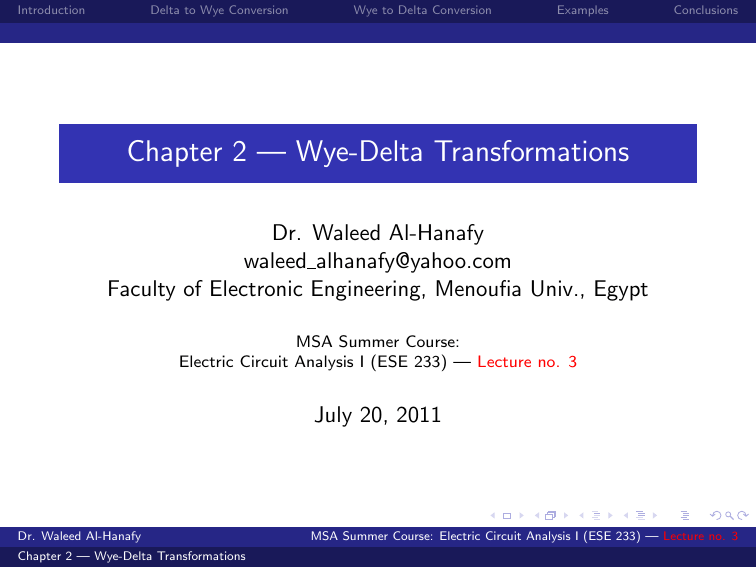
Introduction Delta to Wye Conversion Wye to Delta Conversion Examples Conclusions Chapter 2 — Wye-Delta Transformations Dr. Waleed Al-Hanafy waleed alhanafy@yahoo.com Faculty of Electronic Engineering, Menoufia Univ., Egypt MSA Summer Course: Electric Circuit Analysis I (ESE 233) — Lecture no. 3 July 20, 2011 Dr. Waleed Al-Hanafy Chapter 2 — Wye-Delta Transformations MSA Summer Course: Electric Circuit Analysis I (ESE 233) — Lecture no. 3 Introduction Delta to Wye Conversion Wye to Delta Conversion Examples Conclusions Overview 1 Introduction 2 Delta to Wye Conversion 3 Wye to Delta Conversion 4 Examples 5 Conclusions Reference: [1] Alexander Sadiku, Fundamentals of Electric Circuits, 4th ed. McGraw-Hill, 2009. Dr. Waleed Al-Hanafy Chapter 2 — Wye-Delta Transformations MSA Summer Course: Electric Circuit Analysis I (ESE 233) — Lecture no. 3 Introduction Delta to Wye Conversion Wye to Delta Conversion Examples Conclusions Problem Statement Situations often arise in circuit analysis when the resistors are neither in parallel nor in series. For example, consider the bridge circuit shown. How do we combine resistors R1 - R6 when the resistors are neither in series nor in parallel? Many circuits of the type shown can be simplified by using three-terminal networks. These are the wye (Y) or tee (T) network, and the delta (∆) or pi (Π) network as will be shown next. These networks occur by themselves or as part of a larger network. Dr. Waleed Al-Hanafy Chapter 2 — Wye-Delta Transformations MSA Summer Course: Electric Circuit Analysis I (ESE 233) — Lecture no. 3 Introduction Delta to Wye Conversion Wye to Delta Conversion Examples Conclusions Y, T, ∆, and Π Resistors Connections (a) (a) (b) (b) Two forms of the same network: (a) Y, (b) T. Two forms of the same network: (a) ∆, (b) Π. Dr. Waleed Al-Hanafy Chapter 2 — Wye-Delta Transformations MSA Summer Course: Electric Circuit Analysis I (ESE 233) — Lecture no. 3 Introduction Delta to Wye Conversion Wye to Delta Conversion Examples Conclusions Delta to Wye Conversion R1 = Rb Rc Ra + Rb + Rc (1) R2 = Rc Ra Ra + Rb + Rc (2) R3 = Ra Rb Ra + Rb + Rc (3) Dr. Waleed Al-Hanafy Chapter 2 — Wye-Delta Transformations MSA Summer Course: Electric Circuit Analysis I (ESE 233) — Lecture no. 3 Introduction Delta to Wye Conversion Wye to Delta Conversion Examples Conclusions Wye to Delta Conversion Ra = R2 + R3 + R2 R3 R1 (4) Rb = R1 + R3 + R1 R3 R2 (5) Rc = R1 + R2 + R1 R2 R3 (6) Dr. Waleed Al-Hanafy Chapter 2 — Wye-Delta Transformations MSA Summer Course: Electric Circuit Analysis I (ESE 233) — Lecture no. 3 Introduction Delta to Wye Conversion Wye to Delta Conversion Examples Conclusions Special Cases: Balanced Y and ∆ If in a Y resistors connection R1 = R2 = R3 = RY (7) and in a ∆ resistors connection Ra = Rb = Rc = R∆ , (8) both Y and ∆ networks are said to be balanced and in these cases: RY = Dr. Waleed Al-Hanafy Chapter 2 — Wye-Delta Transformations R∆ 3 or R∆ = 3RY (9) MSA Summer Course: Electric Circuit Analysis I (ESE 233) — Lecture no. 3 Introduction Delta to Wye Conversion Wye to Delta Conversion Examples Conclusions Examples 1 1) Transform the wye network shown to a delta network. Answer: Ra = 140 Ω, Rb = 70 Ω, Rc = 35 Ω. Dr. Waleed Al-Hanafy Chapter 2 — Wye-Delta Transformations MSA Summer Course: Electric Circuit Analysis I (ESE 233) — Lecture no. 3 Introduction Delta to Wye Conversion Wye to Delta Conversion Examples Conclusions Examples 2 2) For the bridge network shown, find Rab and i. Answer: 40Ω, 2.5 A. Dr. Waleed Al-Hanafy Chapter 2 — Wye-Delta Transformations MSA Summer Course: Electric Circuit Analysis I (ESE 233) — Lecture no. 3 Introduction Delta to Wye Conversion Wye to Delta Conversion Examples Conclusions Examples 3 3) Obtain the equivalent resistance at the terminals a-b of the circuit shown. Answer: 36.25Ω. Dr. Waleed Al-Hanafy Chapter 2 — Wye-Delta Transformations MSA Summer Course: Electric Circuit Analysis I (ESE 233) — Lecture no. 3 Introduction Delta to Wye Conversion Wye to Delta Conversion Examples Conclusions Conclusion Concluding remarks In circuit analysis there are situations often arise when the resistors are neither in parallel nor in series. In these situations, it is very helpful to use three-terminal equivalent circuit transformations. These are known as Wye-Delta or Delta-Wye Transformations. Both cases are studied and discussed. Some illustrative examples are given. . Dr. Waleed Al-Hanafy Chapter 2 — Wye-Delta Transformations MSA Summer Course: Electric Circuit Analysis I (ESE 233) — Lecture no. 3
